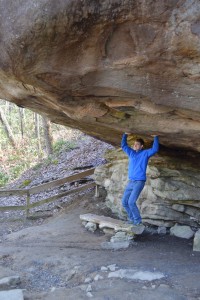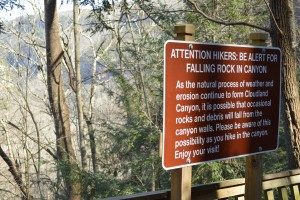The fact that Cloudland Canyon still exists today as a protected space is revealing of the cultural climate of the United States both in the present day and the less recent past. While Cloudland Canyon is the result of millions of years of buildup and erosion and has for itself a human history extending beyond the twentieth and twenty-first centuries, analyzing the exact type of development that has occurred on this land in the modern era allows for a cultural geography study in and of itself. Designated a state park in 1938, Cloudland Canyon was just one of many state and national parks to be set aside during this decade on the tail-end of the conservationist and preservationist movements in order to save these spaces for future generations to enjoy (History of the Georgia State Parks and Historic Sites Division).
 The history of natural spaces secured from the majority of human development in Georgia does not begin with Cloudland Canyon. Nearly a century earlier Indian Springs State Park came into the possession of the state, though it would lacked its official “state park” designation for the majority of that century (Indian Springs State Park). Around this time many other Georgia state parks began to form, including F.D. Roosevelt State Park, Jefferson Davis Memorial Historic Site, Little Ocmulgee State Park, and of course Cloudland Canyon. While setting aside land became a crucial part of the legislative climate and culture, so too did environmental concerns begin to enter into all facets of state and national life. The Civilian Conservation Corps were formed in 1933 with the intention of providing out of work men with purposeful employment and skills during the difficult economic times. Many of their projects, however, had a distinctly environmental focus and involved work on all of the state parks mentioned above, including the construction of the main road leading into Cloudland Canyon for visitors (Georgia State Parks)(Introduction).
The history of natural spaces secured from the majority of human development in Georgia does not begin with Cloudland Canyon. Nearly a century earlier Indian Springs State Park came into the possession of the state, though it would lacked its official “state park” designation for the majority of that century (Indian Springs State Park). Around this time many other Georgia state parks began to form, including F.D. Roosevelt State Park, Jefferson Davis Memorial Historic Site, Little Ocmulgee State Park, and of course Cloudland Canyon. While setting aside land became a crucial part of the legislative climate and culture, so too did environmental concerns begin to enter into all facets of state and national life. The Civilian Conservation Corps were formed in 1933 with the intention of providing out of work men with purposeful employment and skills during the difficult economic times. Many of their projects, however, had a distinctly environmental focus and involved work on all of the state parks mentioned above, including the construction of the main road leading into Cloudland Canyon for visitors (Georgia State Parks)(Introduction).
 Without the introduction of environmental concerns, conservationism and preservationism, the advent of the Georgia Department of Nature resources, and many other organizations and schools of thought that reflect changes in culture it is likely Cloudland Canyon as it is known today would not exist. Without the legal status it possesses there would be nothing barring man from introducing more and more development in the area beyond what already exists immediately adjacent to this natural landmark. This choice and implementation of law reflects an aspect of both past and modern American culture and the shifting role nature has in the collective consciousness of citizens and the result is, hopefully, a space protected in perpetuity.
Without the introduction of environmental concerns, conservationism and preservationism, the advent of the Georgia Department of Nature resources, and many other organizations and schools of thought that reflect changes in culture it is likely Cloudland Canyon as it is known today would not exist. Without the legal status it possesses there would be nothing barring man from introducing more and more development in the area beyond what already exists immediately adjacent to this natural landmark. This choice and implementation of law reflects an aspect of both past and modern American culture and the shifting role nature has in the collective consciousness of citizens and the result is, hopefully, a space protected in perpetuity.
Authored by Julie Fowler
Citations
Georgia State Parks – The New Deal – CCC Structures. (n.d.). Retrieved February 23, 2016, from http://gastateparks.org/item/157417
History of the Georgia State Parks and Historic Sites Division. (n.d.). Retrieved from http://gastateparks.org/item/67911#Cloudland
Indian Springs State Park. (n.d.). Retrieved February 23, 2016, from http://www.stateparks.com/indian_springs_state_park_in_georgia.html
Introduction: The Civilian Conservation Corps. (n.d.). Retrieved February 23, 2016, from http://www.pbs.org/wgbh/americanexperience/features/introduction/ccc-introduction/